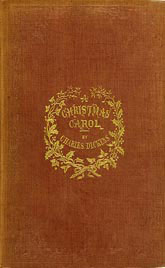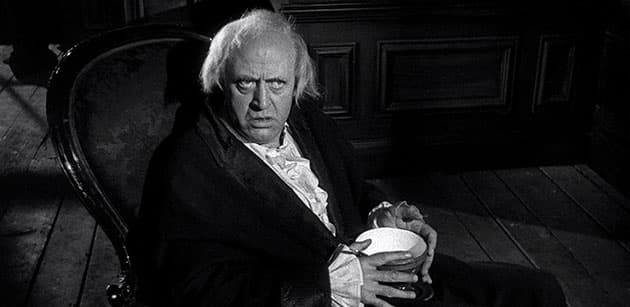A Christmas Carol
Critique • Text • At the movies
 First edition
First editionOriginal title
A Christmas Carol. In Prose. Being a Ghost Story of Christmas.
First publication
1843
Literary form
Novella
Genres
Literary
Writing language
English
Author's country
England
Length
Approx. 28,000 words

Alistair Sim in the 1951 film before the transformation of Scrooge that has delighted generations.
Beloved black-and-white Scrooge
Scrooge (1951): Also known as A Christmas Carol; film, 87 minutes; director Brian Desmond Hurst; writ. Noel Langley; featuring Alastair Sim, Mervyn Johns, Michael Hordern, Kathleen Harrison, Patrick Macnee
It took the Brits to really get it right. The 1951 adaptation, Scrooge (called A Christmas Carol in the United States) is the beloved version we've all seen countless times.
It also made former academic Alastair Sim into a beloved figure for his wonderfully lively, moving and hilarious performance.
It is hard to describe the depth of his performance that allows us to accept without question the transitions from cruelty to fear to recalcitrance to repentance to joyful silliness. Few could watch the last few minutes of Scrooge without tearing up and giggling at the same time.
The film gives him and the other actors time (about an hour and a half) to develop their characters more than earlier adaptations had, in some cases more than in the book. We see Scrooge grow into the monster he becomes in business alongside Marley (the also-great Michael Hordern in a beefed-up role). We also follow his relationship with his long-suffering fiancée in private life.
The Cratchits are still sentimentally portrayed but not cloyingly so—led by character actor Mervyn Johns as a sincere, but deeply feeling, Bob Cratchit.
The cinematography is brilliant. Black and white has seldom been used so effectively in filmmaking outside the American film-noir crime classics. London is dark and cramped and Scrooge's home is dingy and full of shadows. Camera angles accentuate the feeling of doom in the early and middle going and then open up for the joyous finale.
Beware the colourized version of this film. Why oh why would they ruin such a masterpiece in this way? Presumably to curry favour with youngsters who won't watch anything so old that it's black and white. But the pastel backgrounds, the colourful clothes, the overall bright lighting of the coloured film—they just wash the drama from this classic.
In black and white, this is the Christmas Carol—and especially the Scrooge—that all since have measured themselves against.
— Eric

